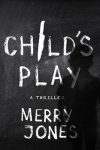

March 13 – 19: “Do apartments, cottages, McMansions or hotel rooms work best for thrillers?”
 Homes in thrillers? Do apartments, cottages, McMansions or hotel rooms work best for thrillers? This week ITW Members Phillip Donlay, Lynn Chandler Willis, David Sakmyster, Michael Niemann, Debra Webb, Merry Jones, Nathan Walpow and Paul A. Barra describe how a home for their protagonists shapes the story.
Homes in thrillers? Do apartments, cottages, McMansions or hotel rooms work best for thrillers? This week ITW Members Phillip Donlay, Lynn Chandler Willis, David Sakmyster, Michael Niemann, Debra Webb, Merry Jones, Nathan Walpow and Paul A. Barra describe how a home for their protagonists shapes the story.
~~~~~
 Merry Jones is the author of non-fiction (including BIRTHMOTHERS), humor (including I LOVE HIM, BUT…) and suspense (including the Zoe Hayes, the Harper Jennings and the Elle Harrison novels.) Her work has been translated into seven languages and has appeared in magazines including GLAMOUR, CHILD and AMERICAN WOMAN. Jones taught college level writing for over a dozen years, has appeared on local and national television and radio to promote her work. She is a member of ITW, Mystery Writers of America, The Authors Guild, and the Philadelphia Liars Club. She lives with her husband in Philadelphia.
Merry Jones is the author of non-fiction (including BIRTHMOTHERS), humor (including I LOVE HIM, BUT…) and suspense (including the Zoe Hayes, the Harper Jennings and the Elle Harrison novels.) Her work has been translated into seven languages and has appeared in magazines including GLAMOUR, CHILD and AMERICAN WOMAN. Jones taught college level writing for over a dozen years, has appeared on local and national television and radio to promote her work. She is a member of ITW, Mystery Writers of America, The Authors Guild, and the Philadelphia Liars Club. She lives with her husband in Philadelphia.
 Michael Niemann grew up in a small town in Germany, ten kilometers from the Dutch border. Crossing that border often at a young age sparked in him a curiosity about the larger world. He studied political science at the Rheinische Friedrich-Wilhelms Universität in Bonn and international studies at the University of Denver. During his academic career he focused his work on southern Africa and frequently spent time in the region. After taking a fiction writing course from his friend, the late Fred Pfeil, he switched to mysteries as a different way to write about the world. His first fiction publication was the story “Africa Always Needs Guns,” which appeared in the 2012 Mystery Writers of America anthology Vengeance, edited by Lee Child. Valentin Vermeulen, his protagonist, first appeared in that story. Check out his latest adventures in Legitimate Business and Illicit Trade.
Michael Niemann grew up in a small town in Germany, ten kilometers from the Dutch border. Crossing that border often at a young age sparked in him a curiosity about the larger world. He studied political science at the Rheinische Friedrich-Wilhelms Universität in Bonn and international studies at the University of Denver. During his academic career he focused his work on southern Africa and frequently spent time in the region. After taking a fiction writing course from his friend, the late Fred Pfeil, he switched to mysteries as a different way to write about the world. His first fiction publication was the story “Africa Always Needs Guns,” which appeared in the 2012 Mystery Writers of America anthology Vengeance, edited by Lee Child. Valentin Vermeulen, his protagonist, first appeared in that story. Check out his latest adventures in Legitimate Business and Illicit Trade.
 Lynn Chandler Willis has worked in the corporate world, the television news business (fun job) and the newspaper industry. She keeps coming back to fiction because she likes making stuff up and you just can’t do that in the newspaper or television news business. Her forthcoming novel, Tell Me No Lies, is the first in the three-book Ava Logan Mystery Series published by Henery Press. Her novel, Wink of an Eye: A Gypsy Moran Mystery, was a Shamus Award finalist and winner of the St. Martin’s Press/PWA Best 1st P.I. Novel competition. She is also the author of The Rising, a Grace Award top winner for Excellence in faith-based fiction, and the best-selling true crime, Unholy Covenant. She is a member of Sisters in Crime, International Thriller Writers, and the Randolph Writers. She lives in the heart of North Carolina with her shelter dog, Finn, a happy border collie who lives for the dog park.
Lynn Chandler Willis has worked in the corporate world, the television news business (fun job) and the newspaper industry. She keeps coming back to fiction because she likes making stuff up and you just can’t do that in the newspaper or television news business. Her forthcoming novel, Tell Me No Lies, is the first in the three-book Ava Logan Mystery Series published by Henery Press. Her novel, Wink of an Eye: A Gypsy Moran Mystery, was a Shamus Award finalist and winner of the St. Martin’s Press/PWA Best 1st P.I. Novel competition. She is also the author of The Rising, a Grace Award top winner for Excellence in faith-based fiction, and the best-selling true crime, Unholy Covenant. She is a member of Sisters in Crime, International Thriller Writers, and the Randolph Writers. She lives in the heart of North Carolina with her shelter dog, Finn, a happy border collie who lives for the dog park.
 David Sakmyster is the award-winning author of more than a dozen novels, including Jurassic Dead, Blindspots and The Morpheus Initiative, a series featuring psychic archaeologists (described as “Indiana Jones meets the X-Files”). He also has an epic historical adventure, Silver and Gold, the horror novel Crescent Lake and a story collection, Escape Plans. His screenplays, Nightwatchers and Roadside Assistance have been optioned for production.
David Sakmyster is the award-winning author of more than a dozen novels, including Jurassic Dead, Blindspots and The Morpheus Initiative, a series featuring psychic archaeologists (described as “Indiana Jones meets the X-Files”). He also has an epic historical adventure, Silver and Gold, the horror novel Crescent Lake and a story collection, Escape Plans. His screenplays, Nightwatchers and Roadside Assistance have been optioned for production.
 Debra Webb is the award winning, USA Today bestselling author of more than 130 novels, including reader favorites the Faces of Evil, the Colby Agency, and the Shades of Death series. With more than four million books sold in numerous languages and countries, Debra’s love of storytelling goes back to her childhood on a farm in Alabama.
Debra Webb is the award winning, USA Today bestselling author of more than 130 novels, including reader favorites the Faces of Evil, the Colby Agency, and the Shades of Death series. With more than four million books sold in numerous languages and countries, Debra’s love of storytelling goes back to her childhood on a farm in Alabama.
 Nathan Walpow’s The Logan Triad, out this month from Down & Out Books, includes three novellas about urban vigilante Logan and his crew of young apprentices. His Joe Portugal mystery series includes four novels, with a fifth coming in 2018. Nathan is a past president of the Southern California chapter of Mystery Writers of America and a five-time Jeopardy! champion
Nathan Walpow’s The Logan Triad, out this month from Down & Out Books, includes three novellas about urban vigilante Logan and his crew of young apprentices. His Joe Portugal mystery series includes four novels, with a fifth coming in 2018. Nathan is a past president of the Southern California chapter of Mystery Writers of America and a five-time Jeopardy! champion
 Philip Donlay learned to fly at age seventeen and was first published at eighteen. In the aviation world, success came quickly and he’s been flying jets since he was twenty years old. Whether flying a Saudi sheik, nighttime freight, or executives of a Fortune 500 company, Donlay has logged over six million miles while spanning the globe. Donlay burst onto the literary scene in 2004 with the publication of his first novel, Category Five, followed by Code Black, Zero Separation, Deadly Echoes, Aftershock, Pegasus Down, and Seconds to Midnight. He is an avid fly fisherman and divides his time between Montana and the Pacific Northwest.
Philip Donlay learned to fly at age seventeen and was first published at eighteen. In the aviation world, success came quickly and he’s been flying jets since he was twenty years old. Whether flying a Saudi sheik, nighttime freight, or executives of a Fortune 500 company, Donlay has logged over six million miles while spanning the globe. Donlay burst onto the literary scene in 2004 with the publication of his first novel, Category Five, followed by Code Black, Zero Separation, Deadly Echoes, Aftershock, Pegasus Down, and Seconds to Midnight. He is an avid fly fisherman and divides his time between Montana and the Pacific Northwest.
 Paul A. Barra is a high school chemistry teacher. Barra was also a reporter with state newspapers and magazines, and was the senior staff writer for the Diocese of Charleston, winning many awards from the S. C. Press Association and from the Catholic Press Association. He is a decorated veteran (Bronze Star with Combat V and the Combat Action Ribbon). He and his wife Joan have eight children and live with their burro, two alpacas, 25 chickens and a Catahoula Leopard hound in Reidville, Spartanburg County, South Carolina. Barra’s publications include four supplementary science readers (Houghton-Mifflin), “St. Joe’s Remarkable Journey” (Tumblar House), “The Secret of Maggie’s Swamp” (Brownridge Press), and “A Death in the Hills” (Argus Books).
Paul A. Barra is a high school chemistry teacher. Barra was also a reporter with state newspapers and magazines, and was the senior staff writer for the Diocese of Charleston, winning many awards from the S. C. Press Association and from the Catholic Press Association. He is a decorated veteran (Bronze Star with Combat V and the Combat Action Ribbon). He and his wife Joan have eight children and live with their burro, two alpacas, 25 chickens and a Catahoula Leopard hound in Reidville, Spartanburg County, South Carolina. Barra’s publications include four supplementary science readers (Houghton-Mifflin), “St. Joe’s Remarkable Journey” (Tumblar House), “The Secret of Maggie’s Swamp” (Brownridge Press), and “A Death in the Hills” (Argus Books).
- LAST GIRL MISSING with K.L. Murphy - July 25, 2024
- CHILD OF DUST with Yigal Zur - July 25, 2024
- THE RAVENWOOD CONSPIRACY with Michael Siverling - July 19, 2024
